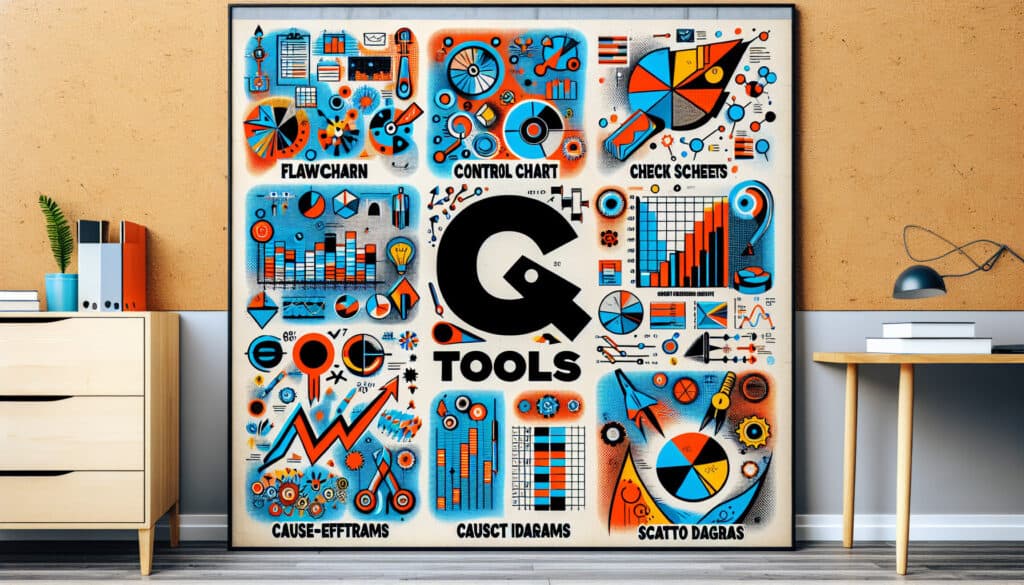A set of fundamental, graphical, and statistical tools for quality control and improvement.
- Methodologies: Economics, Lean Sigma, Manufacturing, Problem Solving, Quality
7 QC Tools

7 QC Tools
- Continuous Improvement, Control Chart, Pareto Chart, Problem Solving Techniques, Process Improvement, Quality Assurance, Quality Control, Quality Management, Quality Management System (QMS)
Objective:
How it’s used:
- These tools are used to collect, analyze, and interpret data to solve quality-related problems. They include tools like Pareto charts, fishbone diagrams, control charts, and histograms.
Pros
- Simple to use, provides a structured approach to problem-solving, and facilitates data-driven decision-making.
Cons
- May not be sufficient for complex statistical analysis, and their effectiveness depends on correct application and interpretation.
Categories:
- Lean Sigma, Manufacturing, Problem Solving, Quality
Best for:
- Identifying and resolving most quality problems in a production environment.
The 7 QC Tools methodology finds applications across various industries such as manufacturing, healthcare, and service sectors, enabling teams to systematically address and resolve quality issues by leveraging practical data analysis techniques. In a manufacturing context, for instance, a team may apply Pareto charts to identify the most frequent defects, directing efforts toward the most significant problems that impact production efficiency. Fishbone diagrams can be utilized during brainstorming sessions to uncover root causes of quality failures, facilitating collaborative problem-solving among cross-functional teams including engineers, quality assurance, and production staff. Control charts are integral in monitoring processes over time, helping practitioners to maintain quality standards by identifying variances that may signal underlying issues. Histogram analyses support the visualization of data distribution, revealing patterns about production consistency and potential areas for improvement. Typically, these methodologies are employed in the quality improvement phase of projects, often initiated by quality managers or team leaders who engage stakeholders throughout the organization. Training sessions on these tools equip participants with the necessary skills to analyze quality issues in real-time, enabling rapid decision-making based on empirical evidence rather than assumptions. Using the 7 QC Tools promotes a culture of continuous improvement, encourages open communication, and empowers teams to take ownership of quality enhancement initiatives.
Key steps of this methodology
- Identify the quality problem to focus on.
- Utilize a Pareto chart to prioritize issues based on frequency or impact.
- Employ a fishbone diagram to analyze root causes of the identified problem.
- Use a scatter diagram to identify relationships between variables.
- Implement control charts to monitor process performance over time.
- Create histograms to visualize the distribution of data related to the issue.
- Conduct a failure mode and effects analysis (FMEA) to evaluate potential failures.
- Use a check sheet to collect qualitative and quantitative data during analysis.
Pro Tips
- Integrate real-time data monitoring with control charts to identify trends as they develop, enabling proactive quality management.
- Utilize multi-dimensional fishbone diagrams to dissect root causes from various perspectives, enhancing collaborative analysis among cross-functional teams.
- Combine Pareto analysis with predictive analytics to not only identify major issues but also forecast potential future problems based on historical data patterns.
To read and compare several methodologies, we recommend the
> Extensive Methodologies Repository <
together with the 400+ other methodologies.
Your comments on this methodology or additional info are welcome on the comment section below ↓ , so as any engineering-related ideas or links.
Historical Context
1962
1970
1972
1980
1980
1986
1986
1960
1963
1970
1980
1980
1980
1986
1987
(if date is unknown or not relevant, e.g. "fluid mechanics", a rounded estimation of its notable emergence is provided)















Related Posts
METS to Calories Calculator
Meta-Analysis
Message Mapping
Mental Model Diagrams
Maximum Acceptable Pushing and Pulling Forces
Material Requirements Planning (MRP)